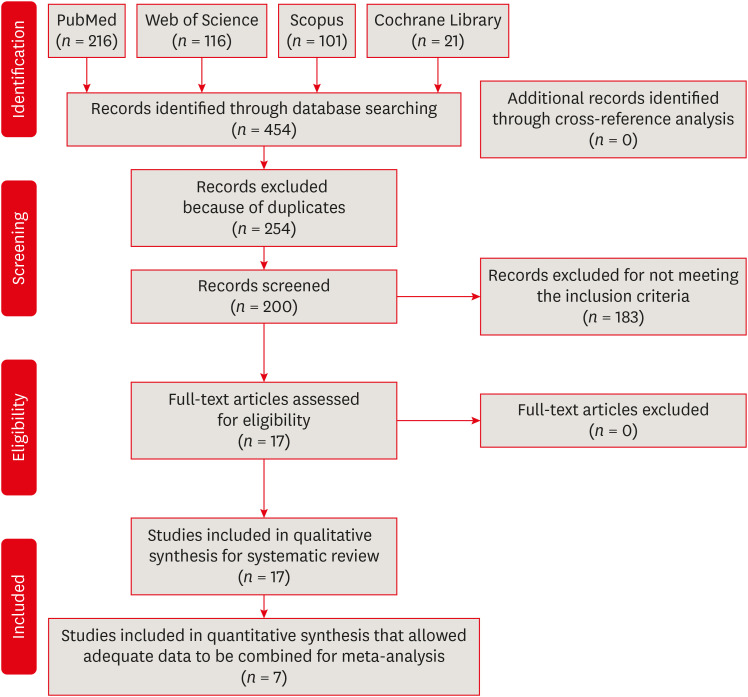-
Influence of reciprocating and rotary instrumentation on microbial reduction: a systematic review and meta-analysis of in vitro studies
-
Selen Küçükkaya Eren, Emel Uzunoğlu-Özyürek, Sevilay Karahan
-
Restor Dent Endod 2021;46(2):e19. Published online March 10, 2021
-
DOI: https://doi.org/10.5395/rde.2021.46.e19
-
-
 Abstract Abstract
 PDF PDF PubReader PubReader ePub ePub
- Objectives
The purpose of this study was to conduct a systematic review and meta-analysis of in vitro studies regarding the effectiveness of reciprocating and rotary instrumentation on microbial reduction in root canals. Materials and MethodsPubMed, Scopus, Web of Science, the Cochrane Library, and the gray literature were searched through December 2019. Studies comparing the influence of reciprocating and rotary instrumentation on the removal of microorganisms from root canals that quantified the antimicrobial effect were included. Data extraction was completed using a systematic form for data collection. The risk of bias of the studies was evaluated. Standardized mean differences (SMDs) and confidence intervals (CIs) were calculated using a random effects meta-analysis. ResultsSeventeen in vitro studies were included in this systematic review, of which 7 provided adequate data for inclusion in the meta-analysis. Both reciprocating and rotary systems were similarly effective in reducing the microbial load in infected root canals (SMD [95% CI], 0.0481 [−0.271, 0.367]). Three studies showed a low risk of bias, whereas most of the studies (82%) presented a medium risk. ConclusionsAlthough both techniques decrease the microbial content (with reductions of 23.32%–88.47% and 23.33%–89.86% for reciprocating and rotary instrumentation, respectively), they are not able to provide complete disinfection of root canals.
-
Citations
Citations to this article as recorded by  - Fifteen years of engine‐driven nickel–titanium reciprocating instruments, what do we know so far? An umbrella review
Felipe Immich, Lucas Peixoto de Araújo, Rafaella Rodrigues da Gama, Wellington Luiz de Oliveira da Rosa, Evandro Piva, Giampiero Rossi‐Fedele
Australian Endodontic Journal.2024; 50(2): 409. CrossRef - Does minimally invasive canal preparation provide higher fracture resistance of endodontically treated teeth? A systematic review ofin vitrostudies
Sıla Nur Usta, Emmanuel João Nogueira Leal Silva, Seda Falakaloğlu, Mustafa Gündoğar
Restorative Dentistry & Endodontics.2023;[Epub] CrossRef - The Effect of Combined Ultrasonic Tip and Mechanized Instrumentation on the Reduction of the Percentage of Non-Instrumented Surfaces in Oval/Flat Root Canals: A Systematic Review and Meta-Analysis
Marcella Dewes Cassal, Pedro Cardoso Soares, Marcelo dos Santos
Cureus.2023;[Epub] CrossRef - Impact of Different Access Cavity Designs and Ni–Ti Files on the Elimination of Enterococcus faecalis from the Root Canal System: An In Vitro Study
Gizem Andac, Atakan Kalender, Buket Baddal, Fatma Basmaci
Applied Sciences.2022; 12(4): 2049. CrossRef - Shaping Properties and Outcomes of Nickel-Titanium Reciprocation Systems in Primary Teeth: A Systematic Review and Meta-Analysis of In Vitro Studies
SelvaKumar Haridoss, Bhavyaa R, Kavitha Swaminathan, Aruna P
Cureus.2022;[Epub] CrossRef - Influence of Root Canal Sealers and Obturation Techniques on Vertical Root Fracture Resistance. An In Vitro Experiment
Mazen F. Alkahtany, Khalid H. Almadi, Fahad A. Alahmad, Abdullah M. Alshehri, Abdulrahman A. AlSwayyed, Omar M. AlZahran, Ali AlHadan, Abdulaziz S. Almustafa, Fahim Vohra, Tariq Abduljabbar
Applied Sciences.2021; 11(17): 8022. CrossRef
-
236
View
-
12
Download
-
6
Web of Science
-
6
Crossref
|




